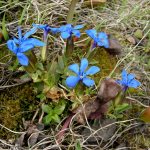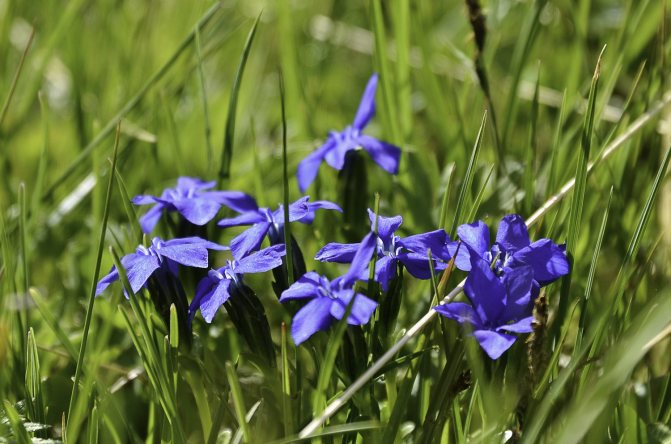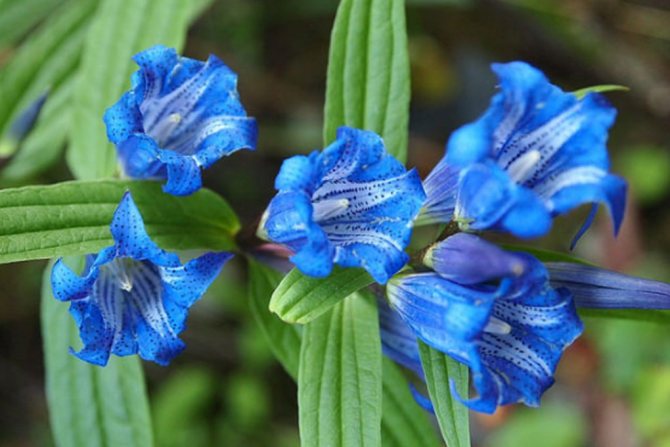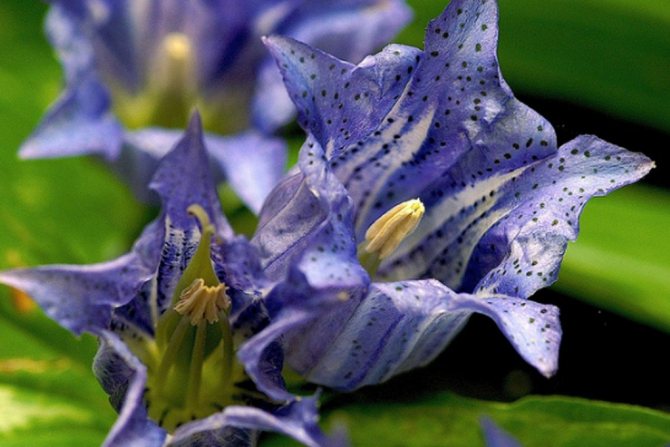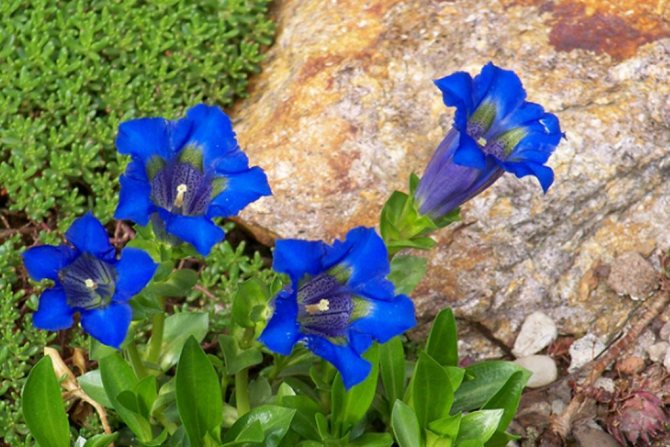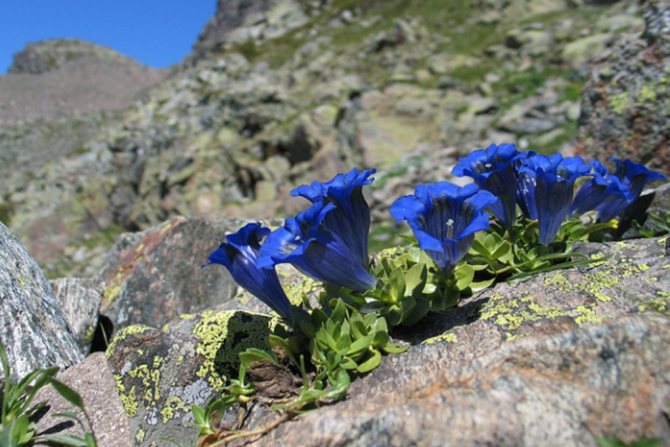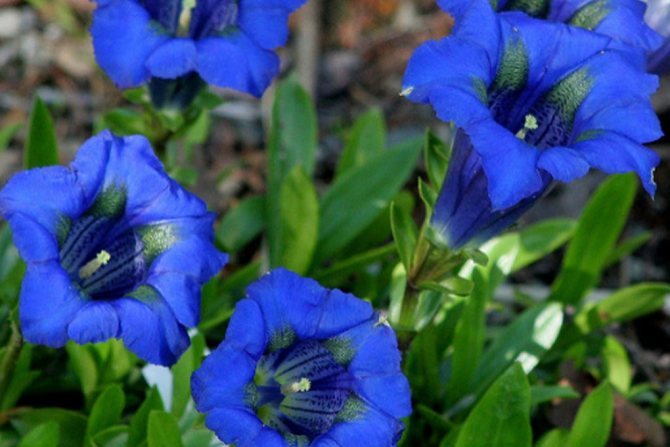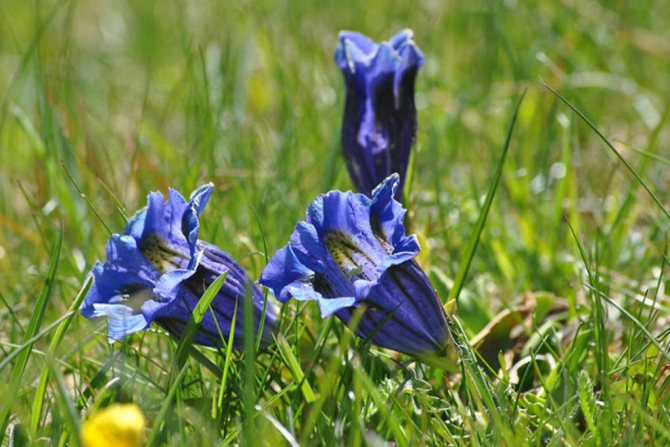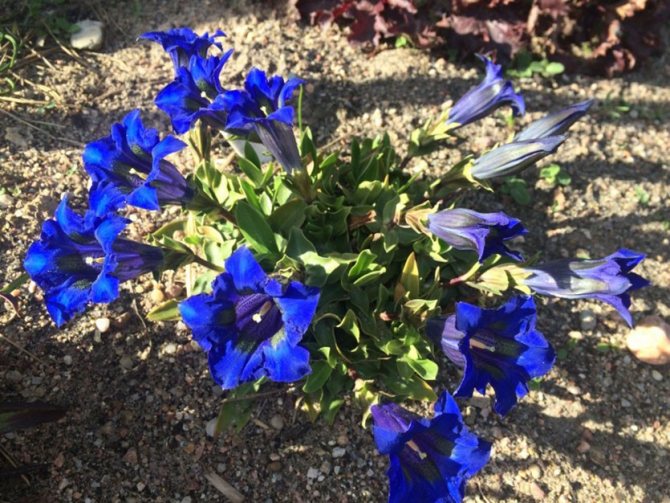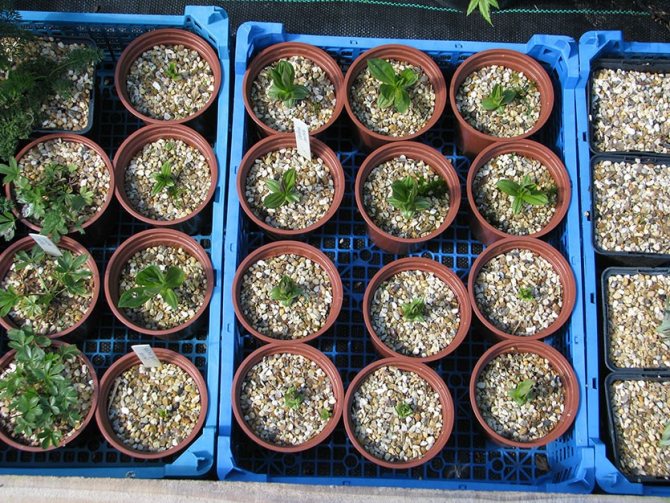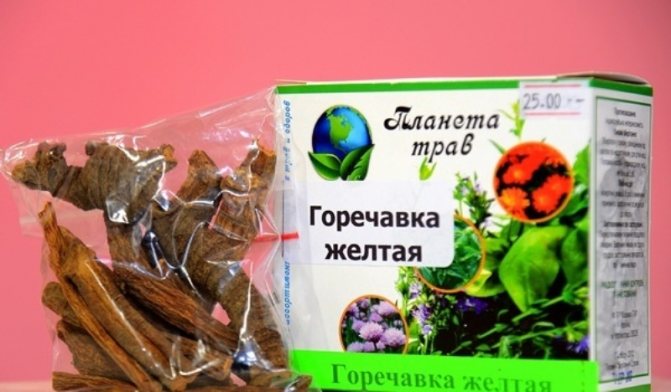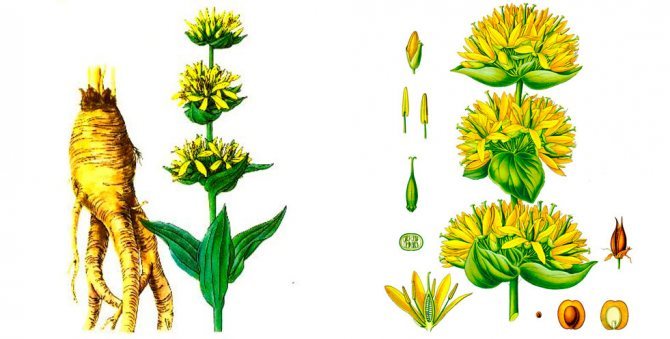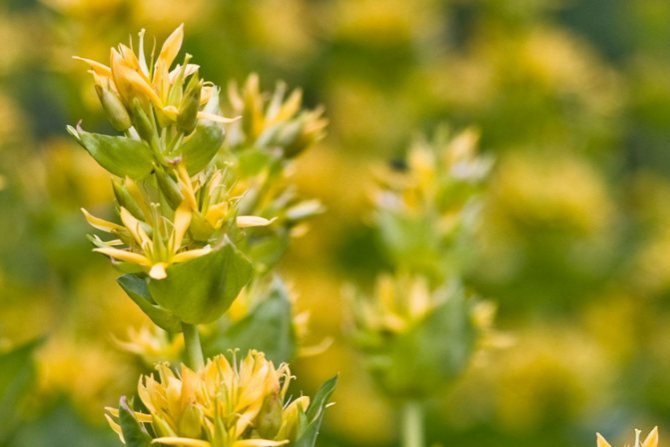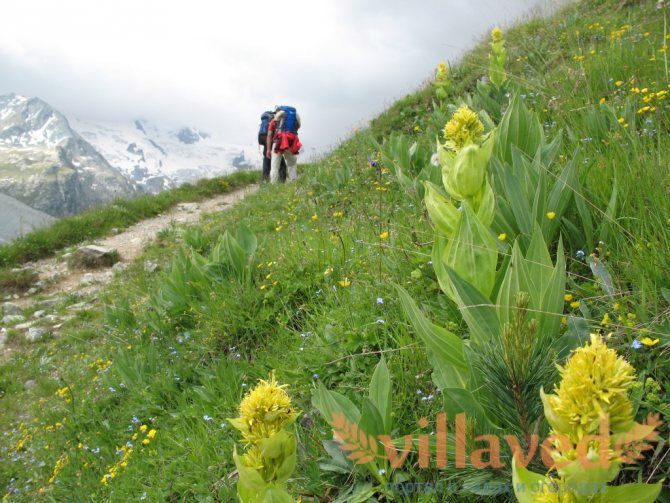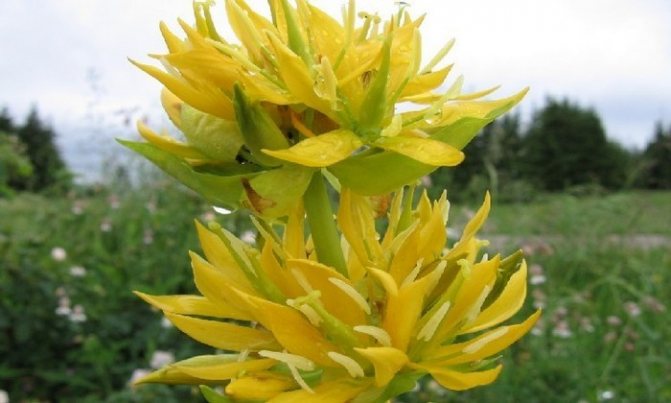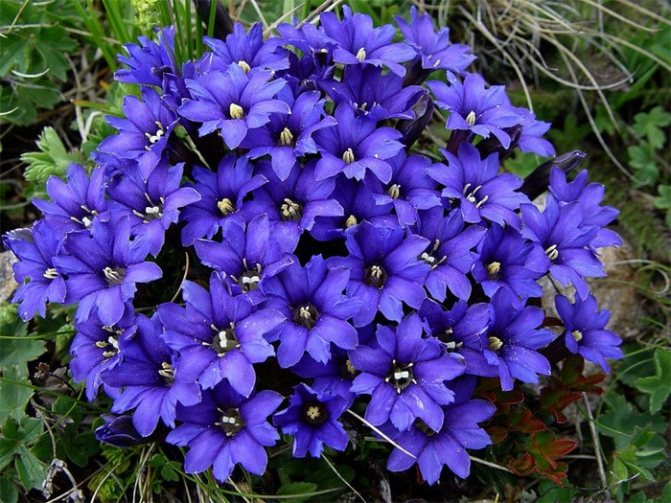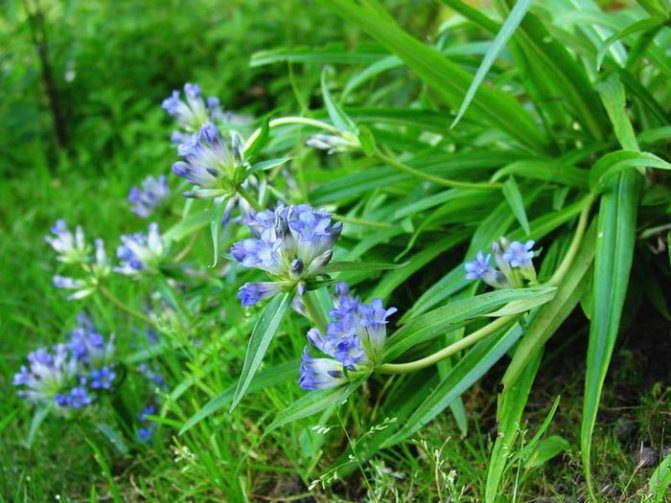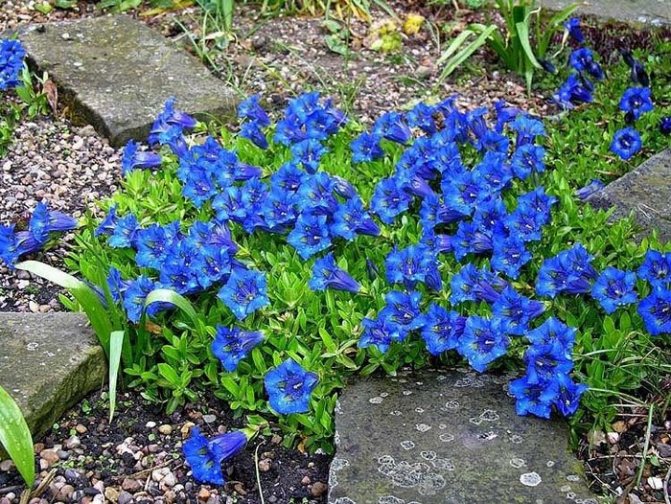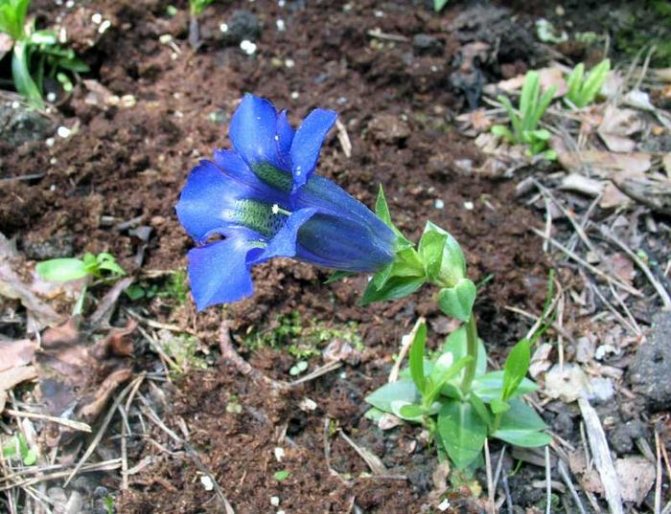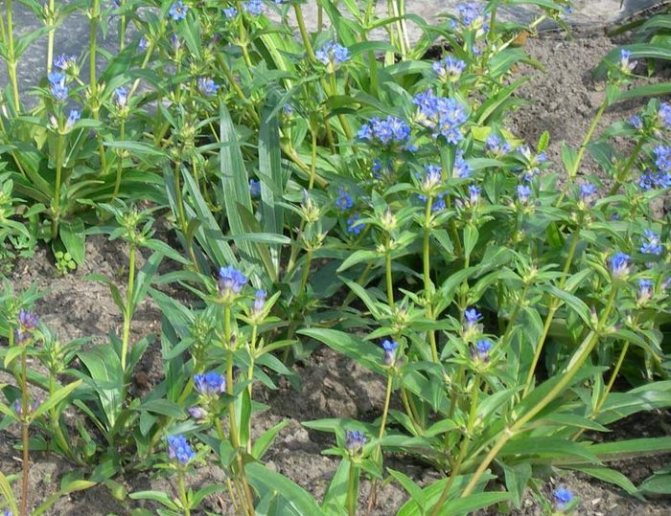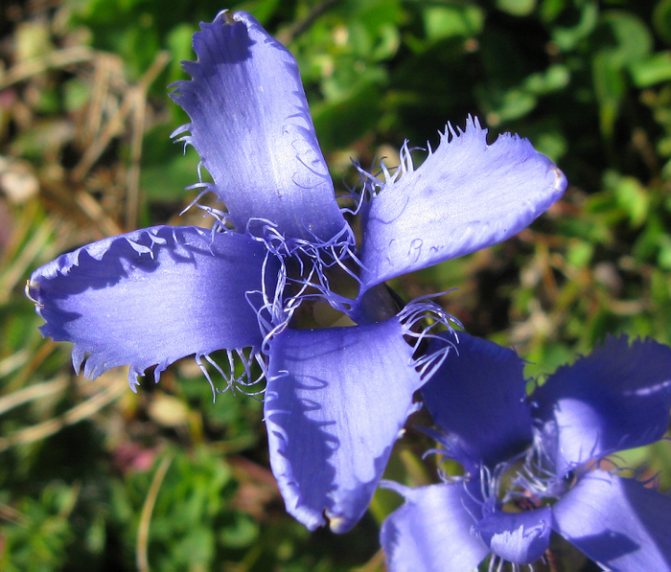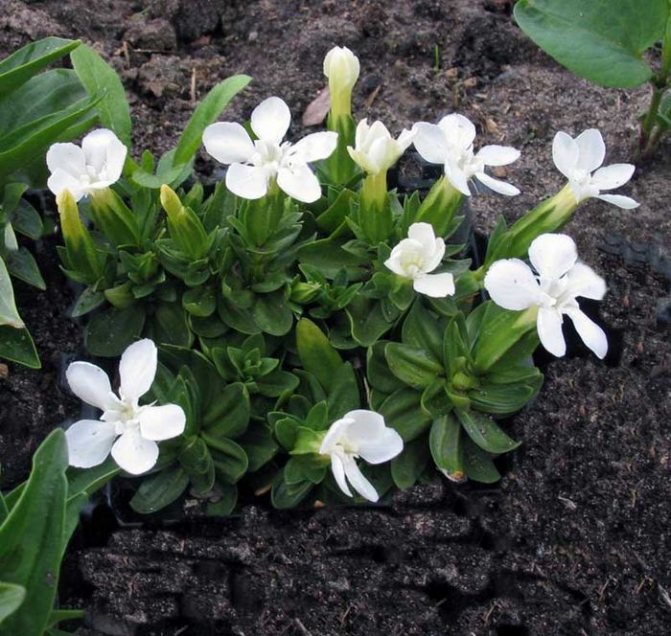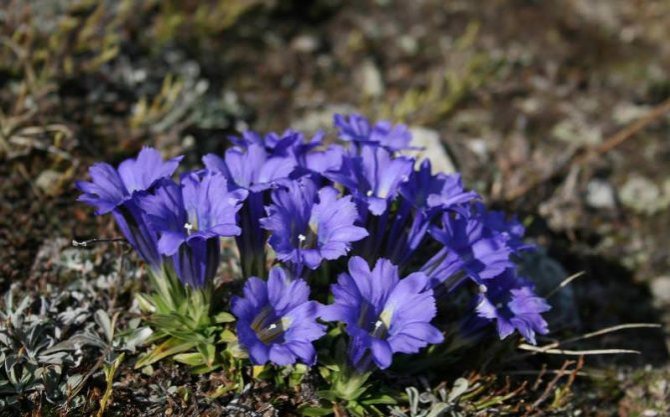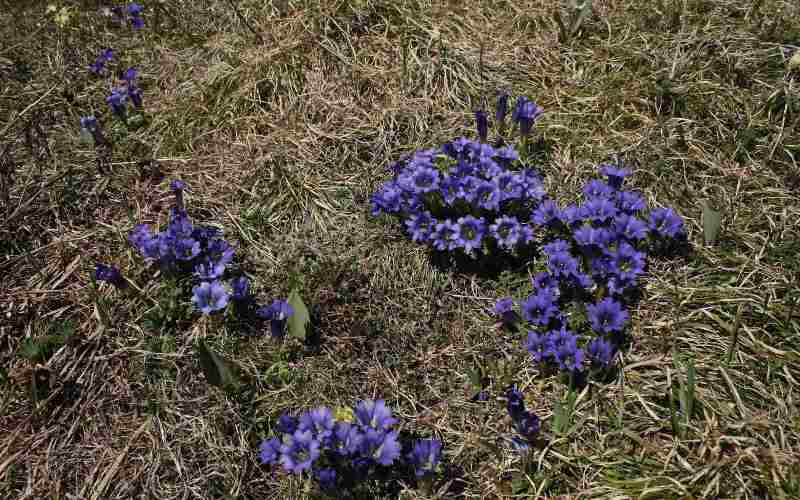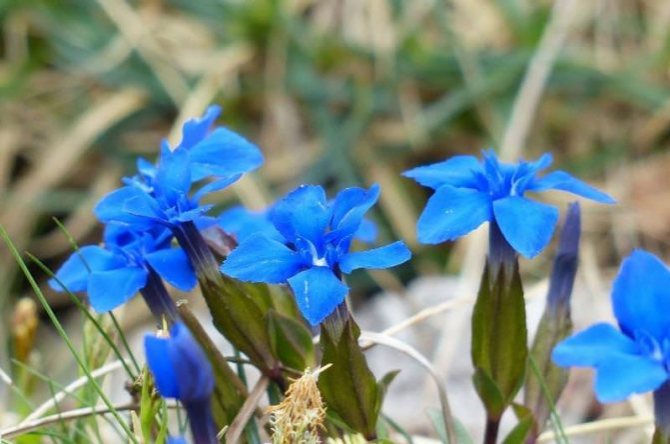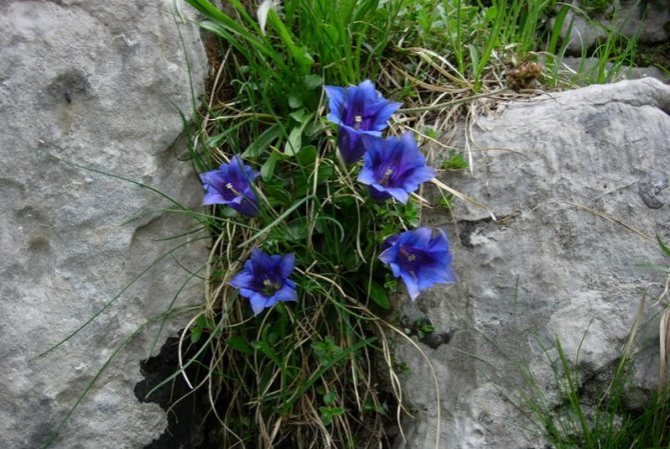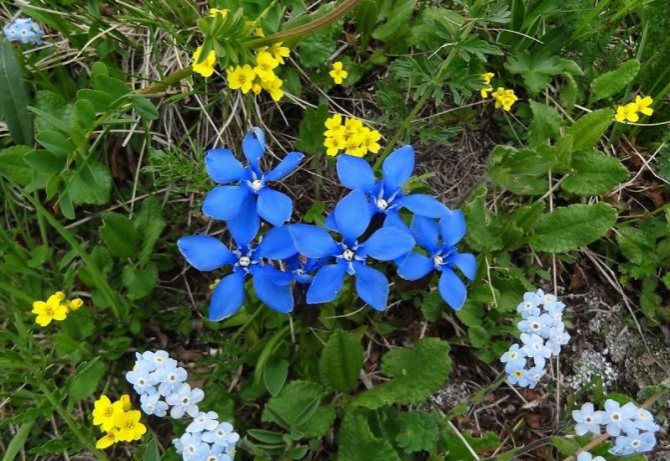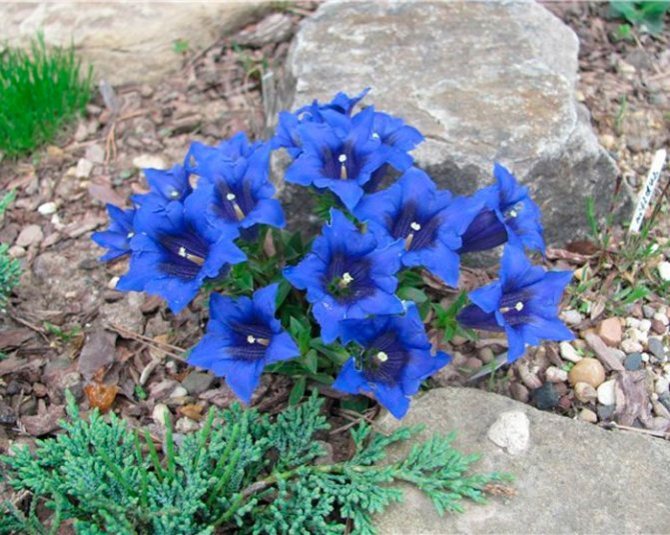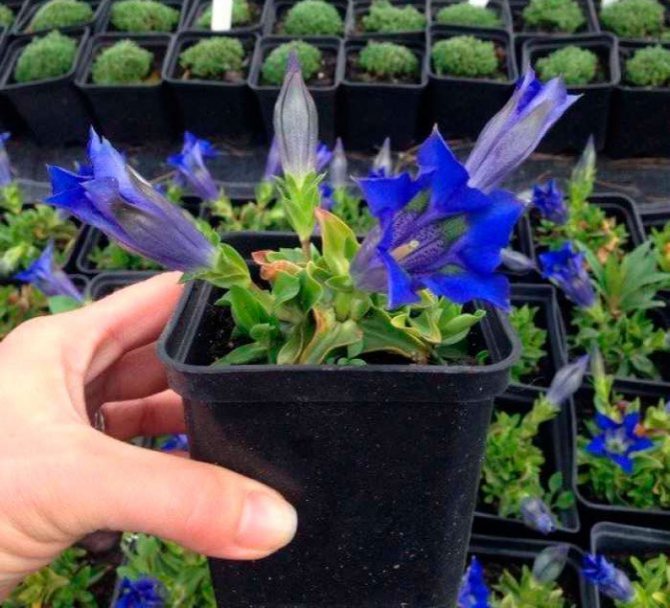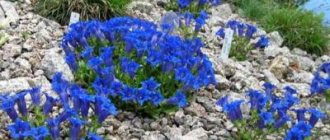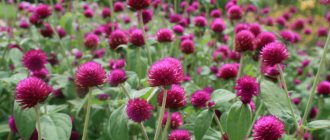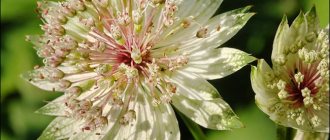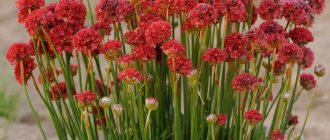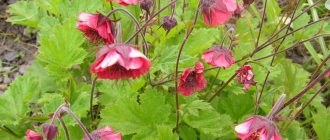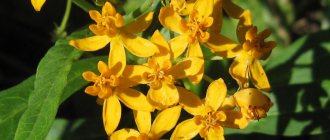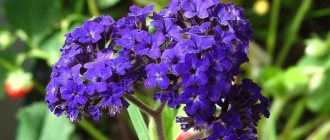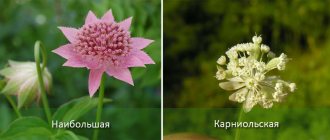The gentian (Gentiana) belongs to the plants that are part of the rather extensive gentian family (Gentianaceae), which contains up to 87 genera. You can meet representatives of the gentian genus in any part of the world, but they mainly grow on the lands of the Northern Hemisphere with a temperate climate. Asia is considered their true homeland. Many of these plants are characteristic of meadows in the alpine and subalpine zones. In the genus itself, botanists have up to 359 species, but only 90 of them grow in natural conditions on the territory of Russia.
| Family name | Gentian |
| Life cycle | Annual or perennial |
| Growth features | Herbaceous, semi-shrub |
| Reproduction | Seed, cuttings or dividing bushes |
| Landing period in open ground | Seedlings are planted in early May or October |
| Disembarkation scheme | Leave 20-25 cm between seedlings |
| Substrate | Directly depends on the type of plant |
| Soil acidity | Depends on the variety |
| Illumination | Well-lit place or partial shade |
| Moisture indicators | Regular watering, especially at the beginning of the growth and flowering period, stagnant water is harmful |
| Special Requirements | Unpretentious |
| Plant height | 10 cm to 1.5 m |
| Color of flowers | Blue, light blue, purple, yellow or snow white |
| Type of flowers, inflorescences | Singles or in groups of several |
| Flowering time | Spring-autumn |
| Decorative time | Spring-autumn |
| Place of application | Decoration of the edging of flower beds and borders, group plantings, rock gardens and rockeries |
| USDA zone | 4–8 |
The genus of these representatives of the flora is named in honor of the Illyrian king Gentius, who lived in the 2nd century BC. According to Pliny the Elder, the ruler used the rhizome of the yellow gentian (Gentiana lutea) to cure his subjects from the plague, and in some sources released in pre-revolutionary times, the plant was referred to under the term - bitterness. The name in Russian comes from the rather bitter taste of the roots and foliage, which is provided by a large number of glycosides, characterized by bitterness. Occasionally you can hear how the plant is named in accordance with the transliteration in Latin - gentian.
Gentians are found both as annual herbaceous growth and perennial dwarf shrubs. The height of their branches varies in the range of 10–150 cm, while the shoots grow straight and, as a rule, shortened. The rhizome is thick, also short, with root processes extending from it, resembling thin cords.
The leaf plates are located on the branches in an opposite order, there are no petioles, they grow sessile, the edge is solid. The foliage is simple oval, with a sharp point at the top. The color is rich green, the surface is glossy.
When flowering, singly located flowers are formed, sometimes they are placed in inflorescences in pairs, forming in the leaf axils. The corolla consists of five, sometimes four members, its outline is in the form of a funnel or a bell, in rare cases it takes the form of a saucer. The color of the petals in flowers is usually a deep blue, blue or purple hue, but there are varieties with snow-white or yellow flowers. The flowering process depends directly on the variety: there are plants that bloom in spring, others have buds in summer or autumn.
After pollination occurs, gentian fruits ripen in the form of a box with a pair of valves. The capsule, filled with small seeds, originates from the ovary, which has a single nest.
The gentian plant is distinguished by its unpretentiousness, and if the flowering process occurs in the summer, then it is customary to form spectacular cascades of them. They are planted next to the retaining walls to decorate the edges of curbs or flower beds. In the spring months, the bright blue flowers are eye-catching in any floral arrangement. If the height of gentian is small, then they are planted between stones in rock gardens and rockeries. The plant, with its stems with foliage, forms dense clumps and when flowering occurs, then all the leaves hide under closely spaced blooming goblet flowers.
Botanical description
The gentian is represented by perennial and annual plants. It is nourished by a fairly thick and short tap rhizome. Cord-like processes extend from it deep into the soil. The flower can take the form of a bush or grass. The height of the shoots is only 5-15 cm, although there are varieties up to 1.5 m high. Opposite sessile leaves are located on hard, short stems. The leaf plates are usually dark green in color. They are lanceolate or oval in shape with a solid side edge and a pointed end.
At the top of the stem, single flowers or few-flowered inflorescences bloom from the axils of the leaves. Depending on the species, they can appear in early spring or early fall. The corolla of the flower resembles a bell and has an elongated tube. The edges of the thin petals are bent to the sides and repeat the shape of a symmetrical five-pointed star. Most gentian flowers are colored in various shades of blue, and are also purple, yellow, or white.
Pollination is produced by insects, which also collect pollen, because gentian is a good honey plant. The fruit is a small seed capsule containing many small seeds.
Diseases, pests and methods of dealing with them
With improper care, gentiana very often suffers from various infections. The most common illnesses include the following:
- Gray rot. It manifests itself as gray-brown spots, in the place of which mold plaque forms over time. The damaged areas must be carefully removed, and the plant itself must be treated with Fundazol.
- Brown spot. The leaves appear ocher-red spots with a dark purple edging. To save the flower, it is sprayed with copper sulfate or Bordeaux mixture.
- Rust. A symptom of the disease is an orange-brown coating on the aerial part of the bitterness. Affected leaves need to be cut off, and the bush itself, together with neighboring plants, should be treated with Fitosporin.
- Root rot. Affects the basal part of the stem. It will not be possible to save a sick gentian, but for the prevention of perennials it is recommended to periodically process "Tsineboy".

Gray rot is manifested by gray-brown spots on the leaves and stems
Pests often appear on gentian. Slugs, snails or ants do not pose a danger to the flower, they are removed mechanically (by hand). But thrips, caterpillars, and sometimes nematodes can ruin the culture if protective measures are not taken in time. Spraying with insecticides (for example, "Aktara") helps from insects living on the green part of the plant. Roundworms that spoil the root system are destroyed by "Nematodos".
Healing properties
The rhizome and shoots of gentian contain many alkaloids, glycosides and other biologically active substances. Due to this, the plant has long been used in folk medicine, and is also used for the preparation of pharmaceuticals. Broths and preparations based on gentian have a high choleretic, expectorant, anti-inflammatory, stimulating effect.
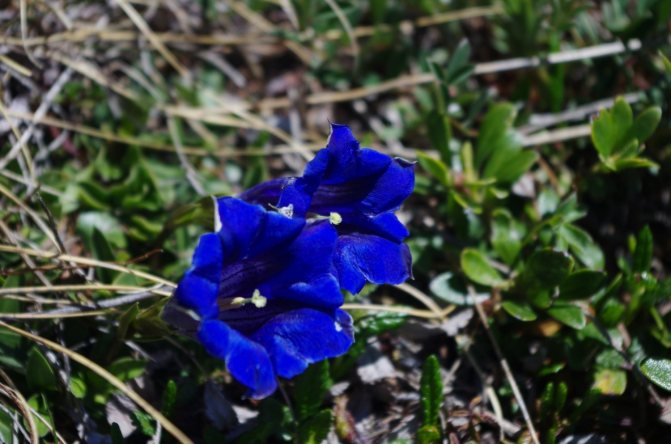

Gentian is used to combat ailments such as:
- cough;
- convulsions;
- arthritis;
- scurvy;
- diarrhea;
- flatulence;
- anemia;
- fever.
It is important not to overuse gentian medications. Overdose leads to increased blood pressure, excitability, dizziness.
Plant species
There are 359 registered species in the gentian genus. In culture, about 90 of them are used. The most famous are the following types:
The gentian is yellow. A large plant up to 1.5 m in height has an erect stem. Its base is framed by a rosette of large oval leaves. The foliage along the stem is more modest in size. Numerous yellow flowers are collected in axillary inflorescences of the upper third of the stem. Flowering occurs in the second half of summer. Each bud, about 25 mm long, consists of pointed petals. Flowering lasts up to 50 days.
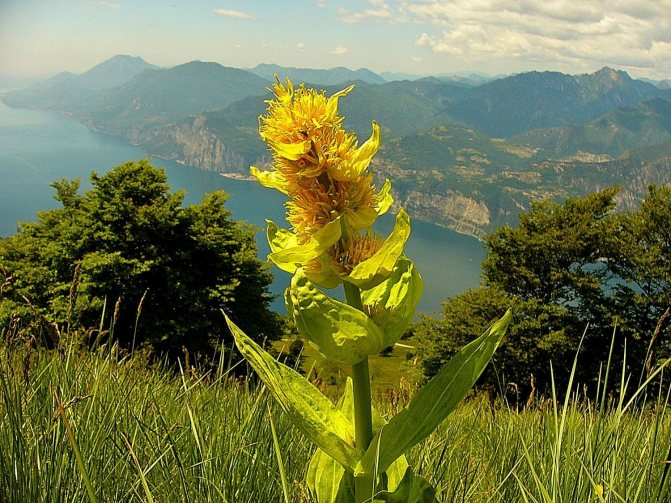

Gentian yellow
Pulmonary gentian (common). The plant has an erect, weakly branched stem 25-50 cm long. Linear or lanceolate-linear leaves are located at the base and rarely along the entire length of the shoot. The length of the leaf plate is 3-7 cm. Axillary flowers are grouped at the top of the stem. The bell-shaped corolla, 1.5-2 cm long, consists of pointed petals. They are painted in a deep dark blue color, on the inner surface at the base there are thin green strokes. Blooms in July-August.
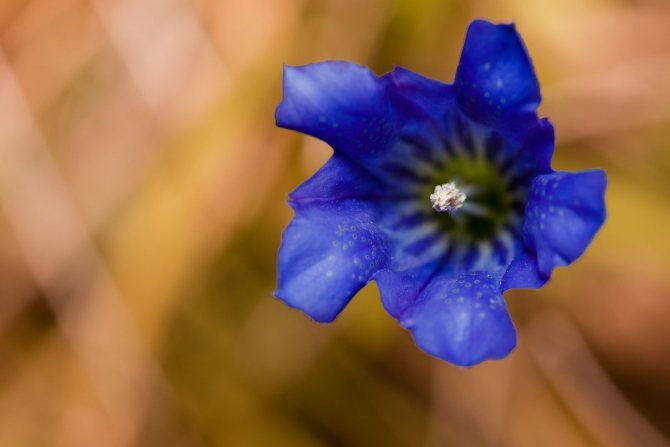

Pulmonary gentian
Dahurian gentian. The variety has softer, erect or lodging shoots 25-40 cm long. They are covered with long, light green foliage. Large dark blue flowers gather in small apical inflorescences. They bloom in July and bloom until the end of August. The plant can be used for cutting and forming bouquets.


Dahurian gentian
Gentian cruciform (cross-leaved). The plant has a thickened taproot and an erect stem up to 50 cm long. It is densely covered with long foliage. Small bell-shaped flowers inside are turquoise in color. Outside, the petals are dominated by gray-green shades. Flowering occurs in the second half of summer.


Gentian cruciform
Gusset gentian. On an upright stem, up to 80 cm high, there are ovoid leaves with a pointed edge. Their length is 6-9 cm. In the axils of the upper leaves on peduncles there are large single flowers. Their length reaches 5 cm. The corolla consists of blue-violet or white petals, collected in a narrow calyx. The buds open from the end of August.


Gentian gorse
Large-leaved gentian. The plant consists of rigid, erect or drooping stems 40-70 cm long. Leaves are collected at the base and rare internodes. Oval leaf plates can reach 20-40 cm in length and 18-30 cm in width. Flowers are collected in dense inflorescences with apical leaves. The length of blue-violet bells is 1.5-2 cm. The edges of the petals are pointed. Blooms in July-August.
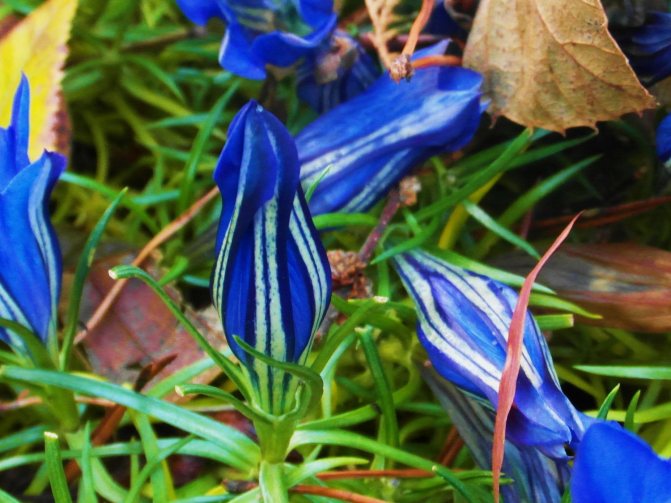

Large-leaved gentian
Gentian stemless (Koha). A miniature alpine variety with a height of no more than 10 cm is especially attractive. Oval leaves of bright green color are collected in basal rosettes. Large tubular flowers of blue, blue or white bloom above them from the end of spring. Flowering is very abundant. It starts in early May and lasts up to 1.5 months.


Gentian stemless
Seven-part gentian. This unpretentious variety grows in a wide shrub up to 30 cm high. Flowers with purple-blue petals bloom above the weakly leafy shoots. The diameter of the bell is 5-7 cm. It blooms in mid-June.
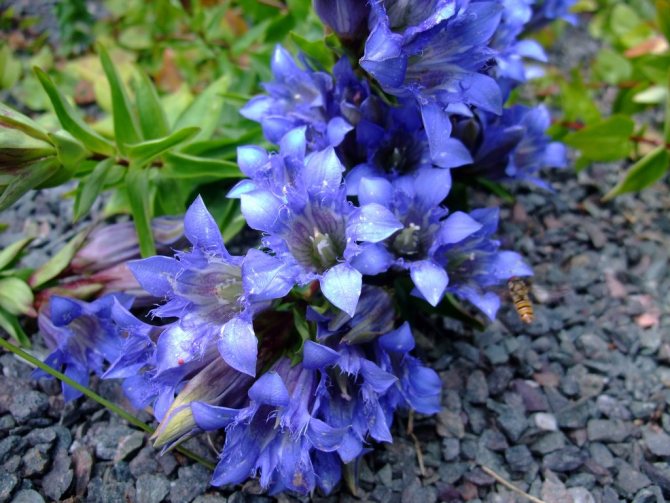

Gentiana septemfida
Aconite, Astrantia, Goldenrod
Now we will select a magnificent retinue for Gentiana asclepiadea /.This gentian variety is very beautiful, with flowers with brightly carved petals. This beauty will suit the classic autumn handsome friends who feel great in partial shade. These are Aconite / Aconitum /, Astrantia / Astrantia /, Common goldenrod / Solidago virgaurea /. All sorts of ornamental cereals are suitable for this gentian variety. Also try combining the Gentian with Geranium sylvaticum, Doronicum, and all Carex species.
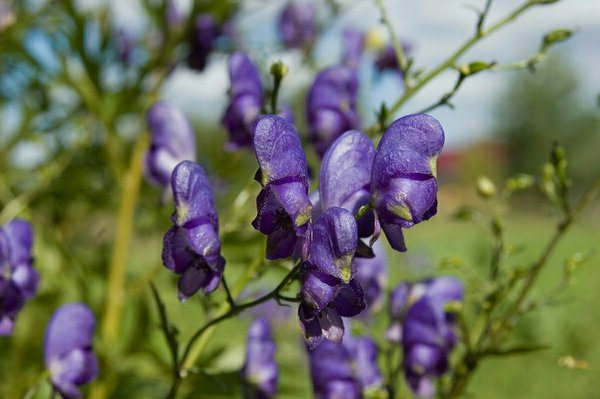

Reproduction methods
Reproduction of gentian can be carried out by seed and vegetative methods. Seeds remain viable for 6-12 months. Cold stratification is required before planting. The seeds are placed in a cool place with an air temperature of no more than + 7 ° C. For thermophilic varieties, one month is enough, high-mountain varieties will need stratification within 2-3 months. During this period, the seeds should be in sandy-peat soil. You can sow them in the open ground in the fall, but do not bury them in the ground, but only press them in. After stratification, the seeds are sown in moist soil and kept at a temperature of + 20 ° C. Seedlings appear in 15-20 days.
In early spring, overgrown bushes can be divided into several parts. The procedure should be carried out very carefully, since the gentian does not tolerate transplantation well. It is important to keep the earthy lump. New plants are carefully transplanted to a new location. After transplanting, it is necessary to water the seedlings abundantly.


Some gentian varieties lend themselves to grafting. In the spring, it is necessary to cut off the top of the stem or the lateral process with 1-2 internodes. Rooting is carried out in water or sandy-peat soil. The process can take up to a month. During this period, the cutting should be watered with caution. To reduce moisture evaporation, it is covered with a glass jar or bag. It is important to ventilate the plant daily. With the appearance of the roots, the seedlings are placed in a permanent place in the garden.
Soil composition and planting site selection
Basically, members of the Gentian family prefer open, sunny places, but can grow in a light lace shade. They like the western, not too hot slopes, where the plant receives a pleasant diffused light.
In completely open sunny rocky areas where the soil heats up and dries quickly, the gentian should be watered frequently.
The main requirement for the soil is good drainage. Although many species grow well in moist soils, along the banks of water bodies, enough air must be supplied to the roots. Therefore, it is worth pouring crushed stone or pebbles into the landing hole, not sparing it.
The composition of the soil for seedlings and an adult plant is as follows: for 2 - 3 parts of leaf humus, 1 part of peat and sand. A glass of wood ash and 30 g of superphosphate are added to 5 liters of such a mixture. Some gentian species require acidic soil. In this case, the dose of peat is increased and the plantings are mulched with pine needles.
Care rules
The gentian in nature is a hardy plant, ready to adapt to harsh conditions. Alas, in culture it is more capricious. The genus combines species with different habitats, so they need different care.
Lighting. Gentians prefer areas in the open sun (seven-part, Daurian, cruciform, yellow) or in a small shade (gorse). Deep shade is contraindicated for all plants.
Temperature. The bushes are adapted to temperate climates and frosty winters, therefore they do not need additional shelter. They tolerate frost and summer heat normally.
The soil. The gentian prefers light, well-drained soils with moderate fertility. Sandy or loamy soils with the addition of small stones are suitable for it. Neutral acidity is preferred.Yellow gentian and stemless gentian need additional limestone mulching. Regardless of the type, stagnant water is unacceptable.
Watering. Plants need regular watering. During dry periods, daily irrigation with small portions of liquid may be required.
Fertilizer. From May to August, it is recommended to fertilize the gentian monthly with a half portion of mineral fertilizers. Use formulations for flowering garden plants. If the soil is fertile enough, you can do without top dressing.
Necessary lighting
It is very important that they have enough light, otherwise you will never get such bright corollas, as in the photo. The gentian thrives in partial shade, but the lack of light is bad for her. Being deprived of sunlight, the stems are stretched, this affects the decorative effect and quality of flowering. Like all mid-summer varieties, they should not be planted in areas that are exposed to the midday sun. A good option would be to choose a location near water bodies or water basins.
Despite the fact that they are usually considered as a culture for rock gardens, the classic southern locations are not at all preferable for them. Delicate corollas fade in the bright sun. In addition, the soil here will dry out very quickly. Therefore, in rockeries it is best to use them in Western exhibitions. Then the plants will delight you with exquisite flowers.
Gentian in the garden
The gentian is good on rocky areas and in rockeries. This is how she looks the most natural. It is advisable to use group plantings, then a solid carpet will cover the allotted area. It will delight you with sapphire shades, which are rarely found in nature.
In the flower garden, tall plants are used in central positions, and undersized species are used in the foreground. Blooming or ornamental plants should be placed next to them, which do not grow too much. It can be sage, sedge, bells. You can plant gentian in front of coniferous and deciduous shrubs. The neighborhood with medium-sized cereals is also effective.
Post Views: 3
Wintering
This is the moment that raises the most questions for flower growers. In fact, this plant does not require complex maintenance. The gentian is a hardy culture that thrives in the mountains and in extreme conditions. Therefore, in central Russia, as well as in Siberia, it hibernates without any shelter. exceptions may be high rock gardens, on which snow does not linger. Without natural shelter, flowers can freeze and come out badly in the spring.
In this case, you need to take care to keep the snow on the artificial slide. To do this, it is necessary to build a semblance of a grid, which is laid out with spruce branches. It will keep snow well and your plants will be safe.

